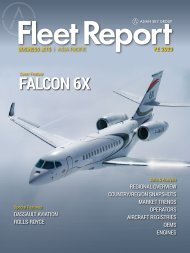Asia-Pacific AAM Report 1H 2023
Create successful ePaper yourself
Turn your PDF publications into a flip-book with our unique Google optimized e-Paper software.
INTERVIEW WITH STUTTGART UNIVERSITY OF APPLIED SCIENCES<br />
Moreover, the subtleties of the passenger experience play<br />
a significant role. The takeoff and landing phases, widely<br />
acknowledged as the most nerve-wracking aspects of any flight,<br />
remain a paramount challenge in ensuring passenger comfort<br />
within an autonomous eVTOL, especially considering the unique<br />
surroundings associated with each flight path.<br />
To address these concerns, researchers and developers are<br />
striving to create intuitive and responsive autonomous systems<br />
that can emulate the expertise and human touch of seasoned<br />
pilots. Advancements in artificial intelligence, such as the AI<br />
pilot model developed at Carnegie Mellon University's Robotics<br />
Institute, leverage natural language processing and speech<br />
recognition capabilities to humanize interactions and coordination<br />
with pilots and air traffic controllers.<br />
Thus far, simulation tests have yielded promising results,<br />
showcasing the AI's effectiveness in navigating complex and everchanging<br />
conditions inherent to typical eVTOL flight paths operating<br />
under visual flight rules (VFR), potentially in segregated lanes.<br />
Furthermore, ease of use and passenger interface are crucial<br />
factors. As passengers become more actively engaged in their<br />
flight experiences, operators in this emerging market must prioritize<br />
a seamless user journey as a key selling point. Initially, interacting<br />
with an autonomous system may feel unfamiliar and disconcerting<br />
to many. Therefore, an empathetic user experience (UX) design<br />
needs to be developed, one that fosters a sense of control, comfort,<br />
and safety, bridging the gap between users and automation.<br />
Operator's Perspective: Refinement for<br />
Efficiency and Safety<br />
From the operator's standpoint, autonomous eVTOLs present a<br />
distinctive array of challenges that need to be addressed. The<br />
paramount concern revolves around maintaining optimal levels of<br />
efficiency and safety in uncrewed operations.<br />
Operators must develop robust fail-safe systems, ensuring their<br />
ability to conduct maintenance tasks swiftly and reliably, and<br />
regularly update the machine learning algorithms that govern the<br />
aircraft's functions. In this context, efficient data management and<br />
real-time monitoring systems play an indispensable role, allowing<br />
operators to predict and proactively address potential failures.<br />
The second area of concern pertains to air traffic control for<br />
eVTOLs. As the skies become increasingly populated with<br />
autonomous aircraft, a sophisticated system must be in place to<br />
manage the escalating volume of air traffic and facilitate the safe<br />
coexistence of autonomous and piloted flights. Regulatory bodies<br />
like the Federal Aviation Administration (FAA) will undeniably<br />
exert a significant influence in shaping the management of<br />
competitive and uncontrolled airspace, with an unwavering<br />
commitment to ensuring absolute safety.<br />
It is anticipated that substantial capital investment and<br />
collaboration with aviation regulators will be necessary to<br />
formulate and establish operational frameworks that fulfill<br />
the unique safety requirements of eVTOL systems. These<br />
<strong>1H</strong> <strong>2023</strong> ASIA-PACIFIC <strong>AAM</strong> REPORT | 53
















